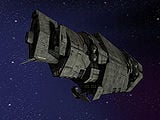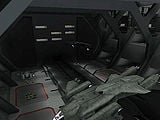Halcyon-class light cruiser: Difference between revisions
From Halopedia, the Halo wiki
(→Armory) |
|||
| Line 82: | Line 82: | ||
At 1.17 (Again, a reference to the number [[List_of_%22Seven%22_References_in_Halo#117|117]]) kilometers in length and one-third the tonnage of the succeeding ''Marathon''-class, the ''Halcyon''s were the smallest of vessels to be designated and structured as cruisers. Compared to later ships, the original ''Halcyon''s were sorely underpowered and under gunned: their Mark II fusion engines provided but a tenth of the output of modern reactors and their armament consisted of a mere six [[Archer Missile]] pods and a single [[MAC]] gun. | At 1.17 (Again, a reference to the number [[List_of_%22Seven%22_References_in_Halo#117|117]]) kilometers in length and one-third the tonnage of the succeeding ''Marathon''-class, the ''Halcyon''s were the smallest of vessels to be designated and structured as cruisers. Compared to later ships, the original ''Halcyon''s were sorely underpowered and under gunned: their Mark II fusion engines provided but a tenth of the output of modern reactors and their armament consisted of a mere six [[Archer Missile]] pods and a single [[MAC]] gun. | ||
As the ship was designed and manufactured well and long before the Human-Covenant War, it was probably meant to suppress possible rebellions on outer colonies which might have had reasonable ground militia but scarce planetary defenses, making the ship ideal to take out small defending frigates or fighters and capable of landing an able ground force to restore order on the planet. The most noteworthy design feature was a series of internal cross bracings and honeycombs that made the ships surprisingly resistant to battle damage; ships of the class were able to remain operational despite sustaining breaches to all compartments and losing 90% of their armor.<ref>[[Halo: The Fall of Reach]], page 238</ref> The durability of the design was demonstrated by the {{UNSCShip|Pillar of Autumn}} when she survived a crash-landing on [[Alpha Halo]].<ref>[[The_Maw_(Level)|The Maw]] (level)</ref> | As the ship was designed and manufactured well and long before the [[Human-Covenant War]], it was probably meant to suppress possible rebellions on outer colonies which might have had reasonable ground militia but scarce planetary defenses, making the ship ideal to take out small defending frigates or fighters and capable of landing an able ground force to restore order on the planet. The most noteworthy design feature was a series of internal cross bracings and honeycombs that made the ships surprisingly resistant to battle damage; ships of the class were able to remain operational despite sustaining breaches to all compartments and losing 90% of their armor.<ref>[[Halo: The Fall of Reach]], page 238</ref> The durability of the design was demonstrated by the {{UNSCShip|Pillar of Autumn}} when she survived a crash-landing on [[Alpha Halo]].<ref>[[The_Maw_(Level)|The Maw]] (level)</ref> | ||
When the [[Human-Covenant War]] erupted in [[2525]] a number of ''Halcyon'' cruisers were reactivated from storage and refitted. | When the [[Human-Covenant War]] erupted in [[2525]] a number of ''Halcyon'' cruisers were reactivated from storage and refitted. | ||
Revision as of 21:11, July 13, 2008
Template:Ratings Template:Ship
The Halcyon-class Cruiser (Pronounced 'hal-see-on') (known as Human Attack Ship class C-II[1] by the Covenant) was a class of United Nations Space Command cruiser starship classification designed by Dr. Robert McLees in 2510. Their service lives were short due to a unique hull design that was costly both to construct and to maintain, lack of speed, and concerns about their tactical viability. They were subsequently replaced by the Marathon-class Cruiser.
Facilities
Halcyon-class cruisers are composed of five hexagonal and octagonal sections mounted onto each other. The bridge is slung underneath one of the forward sections and eight docking bays are distributed throughout the ship. There are also slots for twelve lifepods on the ships' undersides. Lastly, the MAC cannon is visible as a bump on the bow.
Corridors on the Halcyon-class were segmented by several retractable containment bulkheads. In the event of an emergency, these bulkheads could be closed and affected sections sealed from the remainder of the ship. A potential application of this was during a hostile boarding action, whereas the atmosphere in the sealed sections could be vented via commands from the bridge, asphyxiating enemy troops.
Armories were located throughout the ship, holding a selection of small arms and their requisite ammunition. Eight docking bays allowed a number of Pelican dropships, Longsword Interceptors, Warthogs and Scorpion Tanks to be carried.[2]
A number of service corridors ran the length of the ship. Although normally restricted to personnel, they could be accessed by lifts in main engineering or connecting passageways from the docking bays. If necessary, these expansive corridors could permit passage to Warthogs and some sections were large enough to accept Pelicans. The corridors served a secondary purpose of lessening the ship's considerable mass, thereby increasing acceleration.
Armory
Known elements of the Halcyon-classes' original armament consisted of the following;
- MAC Cannon(1)
- Archer Pods(6) which were far below standards at the time. Each pod would have contained several individual missiles.
- Shiva Nuclear Warhead (4)
- 50mm point defense guns
Powerplant
Sublight thrust is provided by nuclear fusion reactions which are channeled to six adjacent exhausts at the ship's exterior stern. There are six exhausts visible, two large and four small. These engines are likely powered by deuterium-deuterium reactions. The main engine core consists of several underpowered Mark II reactors which provided 10% of modern engine output. The class was also equipped with a standard and typical slipspace drive for translight speeds.
| Halcyon-class light cruiser locations |
|---|
| Airlock - Armory - Bridge - Class Seven service corridor - Cryo B - Engineering |
| Launch Bay 7 - Lifepods - Maintenance - Mess Hall |
Background
At 1.17 (Again, a reference to the number 117) kilometers in length and one-third the tonnage of the succeeding Marathon-class, the Halcyons were the smallest of vessels to be designated and structured as cruisers. Compared to later ships, the original Halcyons were sorely underpowered and under gunned: their Mark II fusion engines provided but a tenth of the output of modern reactors and their armament consisted of a mere six Archer Missile pods and a single MAC gun.
As the ship was designed and manufactured well and long before the Human-Covenant War, it was probably meant to suppress possible rebellions on outer colonies which might have had reasonable ground militia but scarce planetary defenses, making the ship ideal to take out small defending frigates or fighters and capable of landing an able ground force to restore order on the planet. The most noteworthy design feature was a series of internal cross bracings and honeycombs that made the ships surprisingly resistant to battle damage; ships of the class were able to remain operational despite sustaining breaches to all compartments and losing 90% of their armor.[3] The durability of the design was demonstrated by the UNSC Pillar of Autumn when she survived a crash-landing on Alpha Halo.[4]
When the Human-Covenant War erupted in 2525 a number of Halcyon cruisers were reactivated from storage and refitted.
Ships of the Line
- UNSC Pillar of Autumn- Destroyed by John-117 in Battle of Installation 04.
- UNSC Dawn Under Heaven- Unknown
Trivia
- After refitting, the Pillar of Autumn was selected for the mission to capture a Prophet due to the Cruiser's resilience and durability.
Images
- RocketArmory.jpg
An armory.
Other
The word "Halcyon" is of Greek descent and means calm or peaceful.
Sources
- ^ Halo: The Fall of Reach, page 4
- ^ It is unknown how many auxiliary craft and vehicles a Halcyon can embark. The Pillar of Autumn, depending on the in-game cutscenes, missions, and novels, was shown to carry at least: twelve Longswords, seven Pelicans, four Scorpions, and perhaps in excess of forty Warthogs. The Warthog count is partially based on the text of Halo: The Flood, pages 136-138. The docking bays shown in the cutscenes each revealed berths for sixteen Pelicans as well.
- ^ Halo: The Fall of Reach, page 238
- ^ The Maw (level)


